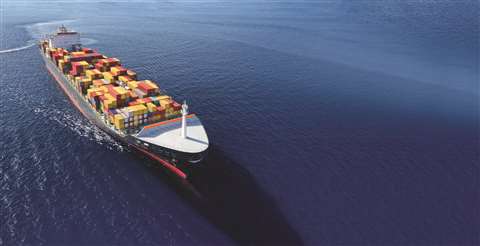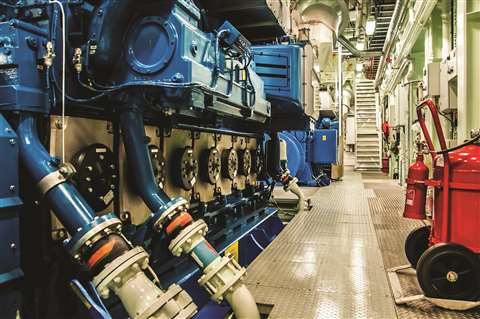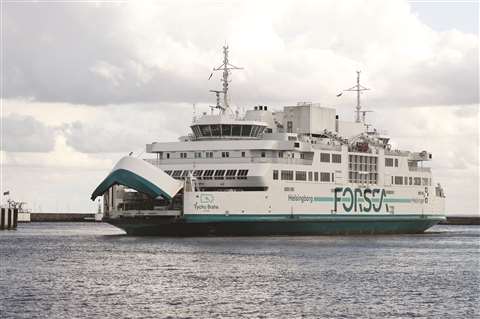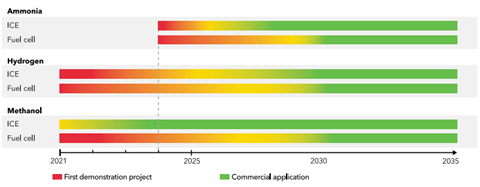Marine Forecast: Industry faces rapid energy and technology changes
08 November 2022
 Driven by decarbonization, the global maritime industry is entering a period of rapid energy and technology transition that will see the testing and adoption of new fuels and power sources. (Photo: DNV)
Driven by decarbonization, the global maritime industry is entering a period of rapid energy and technology transition that will see the testing and adoption of new fuels and power sources. (Photo: DNV)
Editor’s note: Information for this article is derived from the “Maritime Forecast To 2050,” published by DNV, the global assurance and risk management provider headquartered in Høvik, Norway. To access the full report, go to www.dnv.com.
The maritime industry will go through a period of rapid energy and technology transition that will have a more significant impact on costs, asset values and earning capacity than many earlier transitions. Shipowners are already experiencing increasing pressure to reduce the greenhouse gas footprint of maritime transport.
Three fundamental drivers will push decarbonization in shipping in the coming decade: regulations and policies, access to investors and capital, and cargo owner and consumer expectations.
The Initial IMO GHG Strategy currently drives policy development within international shipping, and the first wave of regulations will take effect from Jan. 1, 2023. DNV expects them to have a significant impact on design and operations of all ships.
While all ships need to fulfil the minimum compliance requirements from the IMO, commercial pressure may also push shipowners to aim for a leading position in decarbonization. Poorly performing shipping companies will be less attractive on the charter market and may also struggle to gain access to capital.
The energy and technology transition in shipping has started, with nearly an eighth (12%) of current newbuilds ordered with alternative fuel systems. This is an increase from the 6% reported in 2019. Except for the electrification underway in the ferry segment, the alternative fuels are currently still mainly fossil-based and dominated by LNG.
There will be demonstration projects involving hydrogen and ammonia by 2025 paving the way for zero-carbon ships, and these technologies are likely to be ready for commercial use in four to eight years. Methanol technologies are more mature and have already seen first commercial use. A range of new technologies are emerging, including fuel cells, carbon capture and storage (CCS) and wind power.
Diesels dominate
Currently, the world fleet is mostly powered by diesel engines running on marine fuel oils. LNG-fueled vessels and vessels fueled with liquefied petroleum gas (LPG) and methanol are emerging. The first hydrogen- and ammonia-fueled vessels will soon be entering the world fleet.
While the combustion engine as energy converter will continue to dominate the fleet, marine fuel cells are expected to be integrated in power systems over the next few years.
All alternative fuels for shipping face barriers to their uptake. Typical barriers include the cost of required machinery and onboard fuel storage issues, low technical maturity, high fuel price, limited availability of fuel and a lack of global bunkering infrastructure. Safety will also be a primary concern.
 The world’s marine fleet is mostly powered by diesel engines running on marine fuel oils, but LNG, LPG and methanol engines are beginning to emerge as viable power options. (Photo: DNV)
The world’s marine fleet is mostly powered by diesel engines running on marine fuel oils, but LNG, LPG and methanol engines are beginning to emerge as viable power options. (Photo: DNV)
The technical applicability and commercial viability of alternative fuels will vary greatly for different ship types and trades. Deep-sea vessels, which account for more than 80% of world fleet CO2 emissions, have fewer options compared with the short-sea segment. Deep-sea shipping comprises large ocean-going ships that need to store very large amounts of energy, where the main proportion of energy consumption relates to propulsion of the ship at steady speed over long distances. Options for deep-sea vessels are currently limited to LNG and LPG or to biofuels, which are not yet widely available and are more expensive than LNG and LPG.
The decarbonization options for short-sea vessels are more diverse and include more alternative power sources and driveline configurations. For these ships, electric or hybrid-electric power and propulsion systems can be more efficient than traditional mechanical drives.
It takes time to mature new fuels and developing infrastructure. Twenty years after the introduction of LNG as fuel, there are 509 (as of June 2021) LNG-fueled ships in operation and on order, not including LNG carriers.
The recent uptake of batteries by ferries/passenger ships and service vessels has been quicker. In 2015, the first battery powered car ferry was put into service and, as of June 2021, there are 522 ships in operation and on order with batteries, including fully electric vessels and chargeable and non-chargeable hybrids.
New focus on fuels
There are an increased number of zero-emission pilots and demonstration projects focusing on hydrogen, ammonia and methanol/ethanol. Less than 1% of the ships in operation are running on alternative fuels; however, around 12% of current newbuilds are ordered with alternative fuel systems, about double the 6% reported in 2019.
Over the next few years, DNV sees an increase in deep-sea LNG-fueled ships globally and in batteries for full-electric or part-electric operations in the short-sea segment.
For deep-sea applications, storage capacity is a key barrier to many alternative fuels and the current options are limited to LNG and LPG – which are not carbon-neutral – or to more expensive and less available biofuels.
As of June 2021, 79 ships using LPG as fuel and 25 on methanol are either in operation or on order. These ships are primarily LPG carriers and chemical tankers utilizing their cargo as fuel. LNG and LPG are currently the only alternative fuels that are scalable commercially and globally for long distance transport at sea.
In previous transitions in shipping, the industry moved from wind to coal and steam and then to oil, and every ship made the same transition. This transition will be different as all ships will probably not make a transition to the same fuel.
DNV’s decarbonization pathway modeling shows a diverse energy mix comprising both fossil and zero/carbon-neutral fuels, where fossil fuels are gradually phased out by 2050. The zero/carbon-neutral fuels are introduced both as drop-in alternatives and for use with dedicated technologies.
Fossil LNG is projected to gain a significant share until regulations tighten in 2030 or 2040, depending on the decarbonization pathway. DNV’s modeling shows uptake of carbon-neutral fuel picking up in the late 2030s or mid-2040s, reaching between 60% and 100% of the fuel mix in 2050, depending on decarbonization scenario.
New energy converters
New onboard energy converters could also reduce the CO2 emissions compared with combustion engines. There is growing interest in maturing fuel cell technology in shipping. Fuel cells combined with alternative fuels such as hydrogen and ammonia can efficiently reduce and even eliminate emissions and noise, while energy efficiency can be higher than for conventional combustion engines.
Fuel cells have other potential benefits such as reduced maintenance, modular and flexible design and improved part load operation efficiency. However, fuel cells come with significant disadvantages related to cost and durability.
 Decarbonization options for short-sea vessels are more diverse and include more alternative power sources, such as the electric drive system used on the Swedish car ferry Tycho Brahe. (Photo: DNV)
Decarbonization options for short-sea vessels are more diverse and include more alternative power sources, such as the electric drive system used on the Swedish car ferry Tycho Brahe. (Photo: DNV)
Smaller and medium ships in the short-sea segment may favor low and medium temperature proton exchange membrane (PEM) fuel cell technology. For application on larger deep-sea ships, which can more easily accommodate waste heat recovery solutions, high-temperature fuel cell systems such as molten carbonate fuel cell (MCFC) and solid oxide fuel cell (SOFC) could be explored.
The future uptake of fuel cells is hard to project due to high market and regulatory uncertainties, as well as uncertainty in the anticipated reduction in investment costs for installing fuel cell systems onboard vessels.
Aftertreatment and CCS
CO2 emissions can also be reduced by applying onboard CCS. While it is primarily being developed for larger stationary emissions points such as power generation plants, onboard CCS is a potential option for decarbonizing the deep-sea portion of the world fleet. However, there has not yet been any large-scale demonstration or implementation of onboard CCS systems on merchant ships.
Past DNV studies have shown that marinification of such systems is technically feasible. However, uptake of these systems is being hindered by their complexity, space and resource requirements, costs and lack of applicable rules and regulations. The industry needs financial incentives to subsidize part of the CCS technology costs.
An additional key barrier to this technology is that infrastructure for the total CO2 value chain must be in place and there must be solutions ready to handle the captured CO2 in relevant locations.
DNV’s assessment of the respective fuels and fuel technologies can be summarized as follows:
- Hydrogen: Current barriers to using hydrogen as marine fuel include lack of safety requirements, low maturity of technology, onboard storage space required and high investment cost.
- Ammonia: Key challenges include ammonia’s toxicity, combustion properties, nitrous oxide (N2O) emissions and potential ammonia slip.
- Methanol: Methanol can be stored in integral fuel tanks for liquid fuels if modifications are made to accommodate its low flashpoint properties. Two-stroke methanol engines are commercially available and already have more than 100,000 hours of operations. Four-stroke engines are under development.
DNV has developed a timeline giving its best estimate for when the onboard engine and fuel systems can be expected to be available, with fuel availability not included as a limitation.
 DNV’s timeline for expected availability of onboard alternative fuel technologies for maritime applications. (Photo: DNV)
DNV’s timeline for expected availability of onboard alternative fuel technologies for maritime applications. (Photo: DNV)
A color scale on an accompanying chart indicates two important phases for onboard use:
- First demonstration projects (red): The technology is ready for demonstration on the ship, and the primary intention will be further development and maturation.
- Commercial application (green): The technology is qualified for maritime application through tests and demonstrations and can be applied to commercial use onboard
The timelines do not reflect many other important aspects that will finally determine the actual uptake of these technologies in the fleet – fuel availability (production volumes), distribution and bunkering infrastructure, policy and incentives for uptake, fuel prices, technology cost, etc.
DNV’s timeline shows that methanol technologies are the most mature and have already seen first commercial use. There will be demonstration projects for onboard use of hydrogen and ammonia by 2025, paving the way for zero-carbon ships, and these technologies will be ready for commercial use in four to eight years. Making them available earlier than this will be of great importance for the shipping industry to achieve the IMO’s GHG-reduction ambitions.
The timeline also reflects that fuel cells are far less mature than internal combustion engines. Fuel cells have not been applied commercially in shipping but testing for marine applications has been performed during the last decade.
STAY CONNECTED




Receive the information you need when you need it through our world-leading magazines, newsletters and daily briefings.
POWER SOURCING GUIDE
The trusted reference and buyer’s guide for 83 years
The original “desktop search engine,” guiding nearly 10,000 users in more than 90 countries it is the primary reference for specifications and details on all the components that go into engine systems.
Visit Now
CONNECT WITH THE TEAM









